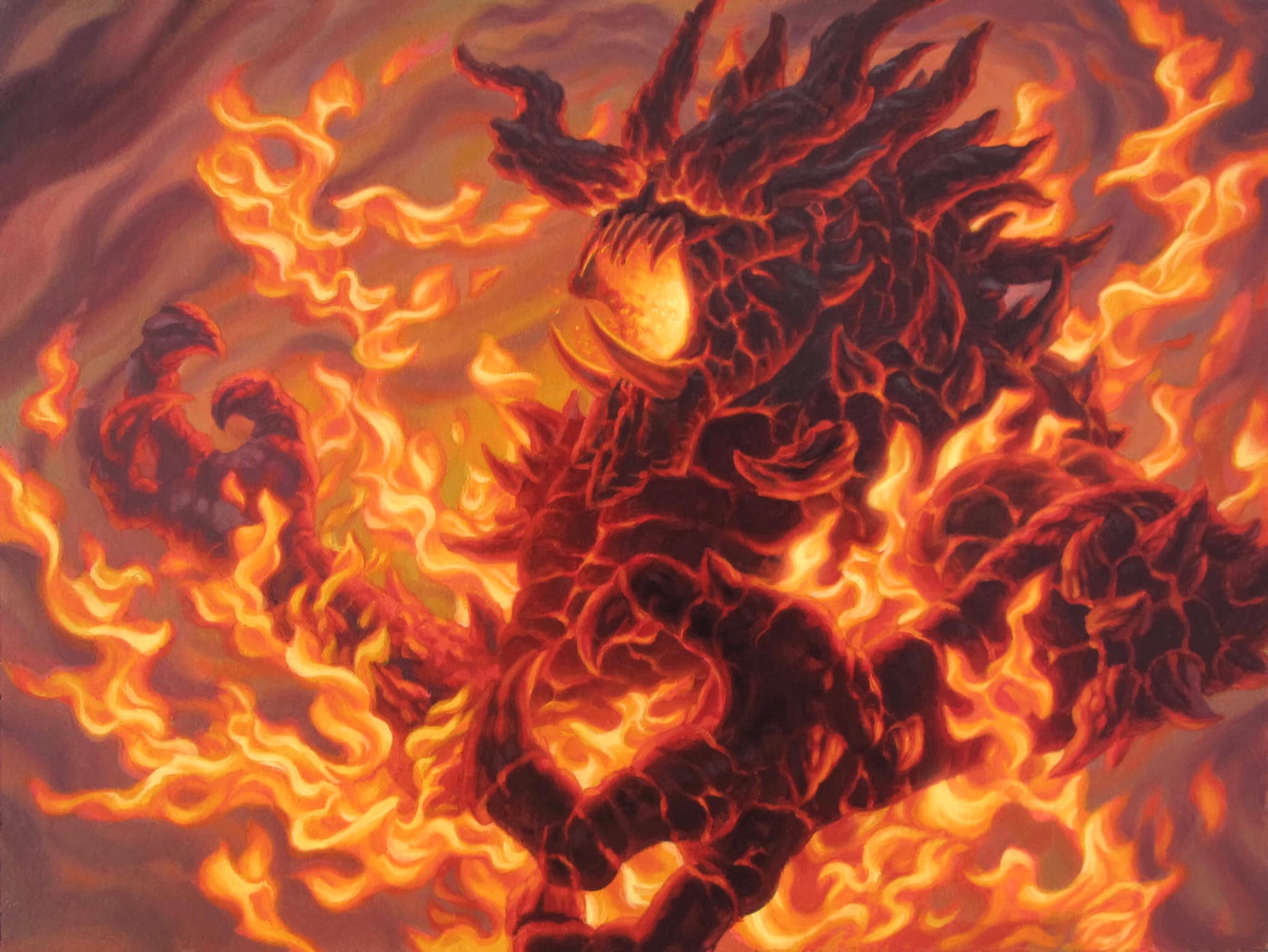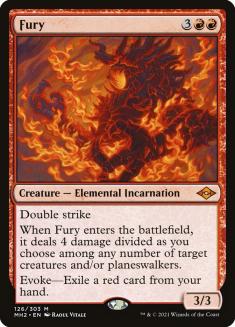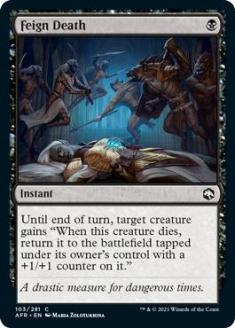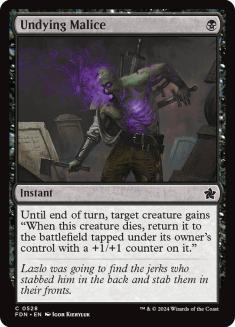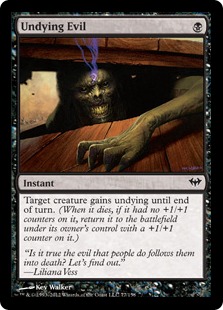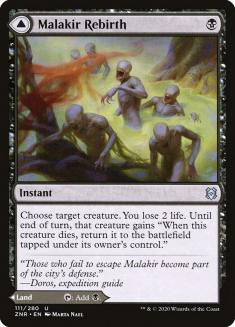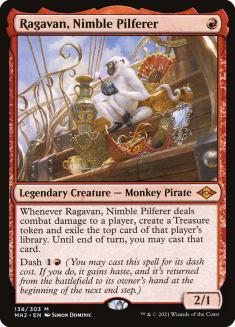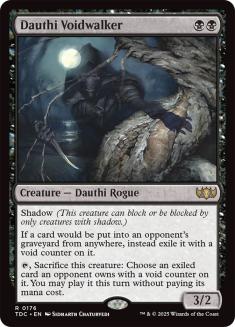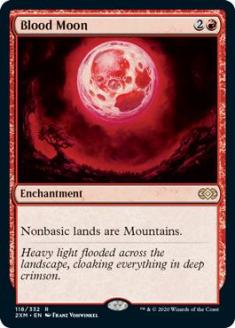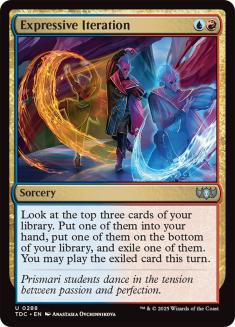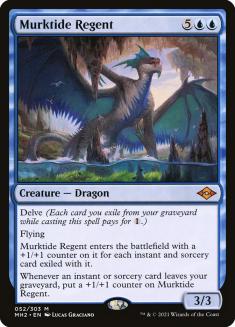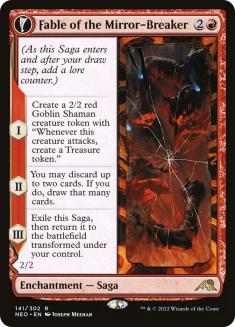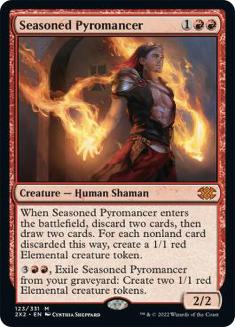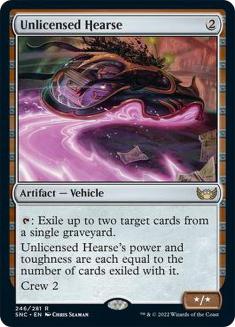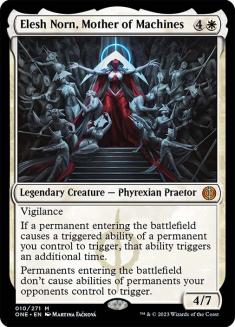One way to gain respect for a deck is to lose to it over and over again. As I mind my own business in Modern tournaments, casting my jolly green giants, there’s one matchup I fear more than any other – the sight of Turn 1 Blackcleave Cliffs sends a shiver down my spine. Rakdos Evoke is a nightmare matchup for Amulet Titan and combo decks in general, but has also proven itself as a solid, powerful strategy with a lot to recommend it.
When I tried many popular decks in Modern to broaden my range for upcoming tournaments, Rakdos Evoke impressed me enough that I resolved to register it soon. I took my shot this weekend for the ManaTraders Series and was glad I did.
Evoke on It
Let’s start with the deck’s trademark gimmick. The evoke Elementals are some of the most powerful and popular cards in Modern. What’s special about them here?
Feign Death effectively blinks a Grief or Fury, bypassing the forced sacrifice from evoke to keep the creature around and doubling up on its trigger. This exchange makes the game much ‘smaller’ by wiping out most of each player’s resources. That favours the Evoke deck on the numbers – though the raw card count is even, you remove two of their best cards from hand or clean up their most threatening permanents at the cost of your most expendable card. The rest of the deck is built with these smaller games in mind. Your curve stops at three mana and most of your cards are cheap, letting you compete in a game with fewer resources.
When these evoke synergies aren’t available, you can help other creatures cheat death. Ragavan, Nimble Pilferer often dies on sight, and Feign Death can force a second removal spell. Dauthi Voidwalker is your most important card in many situations, so a layer of protection for it is valuable, or you can cash in your Voidwalker for an exiled card and still keep it around. Seasoned Pyromancer is an ideal target in the mid-game, and Feign Death lets a Reflection of Kiki-Jiki that’s about to die come back as Fable of the Mirror-Breaker to retell that whole story.
The Feign Death Copycats
There is a surprising variety of Feign Death imitators beyond a literal reprint in Undying Malice – not to be confused with Undying Evil, which leaves the returned creature untapped but doesn’t work if it already has a +1/+1 counter from one of these effects. Malakir Rebirth is more contentious. My first thought on seeing the deck was that you would want to max out on Malakir Rebirth as the most flexible option that helps a land-light deck cast its curve-toppers or hard-cast its evoke creatures. In practice, that missing +1/+1 counter is a big deal for your only threat that’s tasked with ending the game in a short window, especially on Fury, where double strike means double the difference.
The Midrange Mindset
To understand what this deck is, let’s look at what it isn’t.
The classic formula of cheap threats backed up by black’s disruption and removal is the core of the beloved ‘boomer Jund’ strategy that has a devoted following constantly looking to relive its glory days. Following the same template, Rakdos Midrange in Pioneer is arguably the best deck and inarguably the most popular deck.
It’s only natural that fans of these strategies would approach this new Thoughtseize + Fatal Push deck with the same mindset, but this will lead them astray. These decks are popular in part because they give you the feeling of ‘playing Magic’ every game – you always do something, even if that thing doesn’t quite get there in the end, and your decisions about how to use your interaction often make the difference between winning and losing. This style of midrange aims to depolarize its draws with cards that are consistently useful, rather than heroes or zeroes. The inherent flaws of midrange – drawing the wrong interaction or the wrong mix of interaction and threats – are less relevant in a world where threats like Bloodtithe Harvester and Fable of the Mirror-Breaker are more flexible and offer their own filtering.
The tradeoff here is that you have to work for your wins and don’t have the easy games that linear decks can have when all their pieces line up properly. Modern’s powerful sideboard cards against linear decks can offer this – Stony Silence was a big draw to Abzan Midrange in the Mox Opal days, for example – but it’s not what you sign up for.
Striking It Rich
Rakdos Evoke doesn’t want to grind out an honest living. It wants to get rich quick.
This deck embraces the maxim that having a ‘god draw’ is a key hallmark of a good deck and takes it to the extreme. You have so many cards and plans that can singlehandedly run away with the game that they can look out of place alongside each other, but who cares when you just need one to go the distance?
Registering Rakdos Evoke means embracing this polarization. Blood Moon is fantastic against many opponents (including decks that seem like they ‘should’ be resilient against it) and useless against other Ragavan decks. Meanwhile, Dauthi Voidwalker is a terrifying maindeck hate card for some decks and a useless creature that can’t even block elsewhere. Making a 4/4 Fury on Turn 1 will win the game by Turn 3 sometimes and lose it for you when the opponent has the answer. You must be able to handle the swings.
This carries over into mulligan decisions. A typical midrange deck will gladly keep lands and spells with no additional info because its cards offer general coverage. Rakdos Evoke wants to do something powerful, even if it’s not always clear which hands will qualify. The Evoke plan works against that to some degree, as you would rather have an extra, useless card of the right colour to pitch to Grief or Fury (or throw away to Seasoned Pyromancer or Fable of the Mirror-Breaker), but access to that trick is a big draw.
Rakdos Evoke can pivot into a midrange deck as needed – this is explicitly my plan against Izzet, for example – but thinking of it as a wonky combo deck first is more useful in my view.
Rethinking Ragavan
Sometimes Ragavan + removal is all your hand needs, but Modern’s most notorious Monkey has a more complicated role in this deck than in its other homes. You have less interaction to protect Ragavan or let it connect than the conventional Rakdos or Izzet decks, but the Feign Death effects intended for Grief and Fury can also save it. Anyone who has played with Ragavan knows the feeling of the first copy being stalled on the battlefield and the second copy rotting in your hand – but, as we just saw, a redundant Ragavan can be that blank card that you want to toss away.
All of these sequences are common for Rakdos Evoke:
- Cast Turn 1 Ragavan, relying on it to put you ahead early.
- Cast Turn 1 Ragavan as a lightning rod for removal, clearing the way for a follow-up Voidwalker or an evoke + Feign Death sequence.
- Cast Turn 1 Ragavan and avenge its death with Turn 2 Ragavan holding up Feign Death, forcing the opponent to have three removal spells to stop the Ragavan troop.
- Hold off on casting your one copy of Ragavan until you can cast it and hold up Feign Death as protection on Turn 2.
- Decline to cast Ragavan at all, intending to pitch it to Fury/Fable/Pyromancer instead.
This is on top of the usual dance around whether you should cast Ragavan or dash it each turn against sorcery-speed removal. You also want to make sure your sideboard is configured to let you sideboard out Ragavan against matchups like Golgari Yawgmoth, where it can never realistically connect.
The Murktide Menace
The main thing holding Rakdos Evoke back from even greater success is a poor Izzet matchup. They contain your explosive starts with interaction, win card advantage battles with Expressive Iteration, and can exploit your lack of hard removal with a massive Murktide Regent. One bad matchup doesn’t disqualify a deck by itself, but Izzet is a heavy favourite to be the most popular deck at any given Modern tournament.
My experience this weekend was very different – I was 4-0 against Izzet on the weekend, including a pair of wins against prominent Murk-guide author Maxx Kominowski (aka twinlesstwin). I chose my removal suite with the matchup in mind – a full set of Fatal Push to ensure I could kill Ledger Shredder (or Unlicensed Hearse post-sideboard) at any stage of the game and a third Terminate (I wish I had the fourth in the sideboard!) to hedge against Murktide Regent.
With the full set of both Seasoned Pyromancer and Fable of the Mirror-Breaker, as well as the ability to hard-cast Fury and other card advantage options like Night’s Whisper, I found I was keeping up in the mid-game. Unlicensed Hearse proved more reliable than all-or-nothing graveyard hate like Leyline of the Void (which still has a place in matchups like the mirror or Yawgmoth) in containing Murktide Regent and the delirium cards while doubling as a threat in its own right.
In broad terms, this plan involves shifting into more of a midrange deck with fewer copies of Grief and the Feign Death effects and using the remaining copies as conditional protection for Ragavan and Voidwalker more than as proactive combo cards.
A Question Mark and a List
A bigger question mark for me is the new breed of Four-Color Control decks, a tough matchup in the Yorion days but one that looks different now – especially as there is no clear consensus yet over how to build these decks. You can steal games with Blood Moon as always, but it’s hard to know how often that will actually happen.
After a full weekend with the deck and taking cues from other Rakdos Evoke lists that did well, here’s where I would start for SCG CON Charlotte:
Creatures (20)
Lands (19)
Spells (21)

It feels good to be on the right side of Ragavan and Blood Moon for a change. Join me there!

